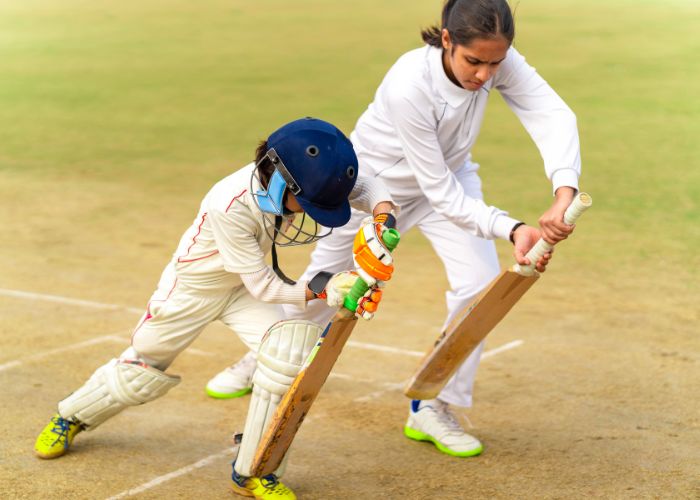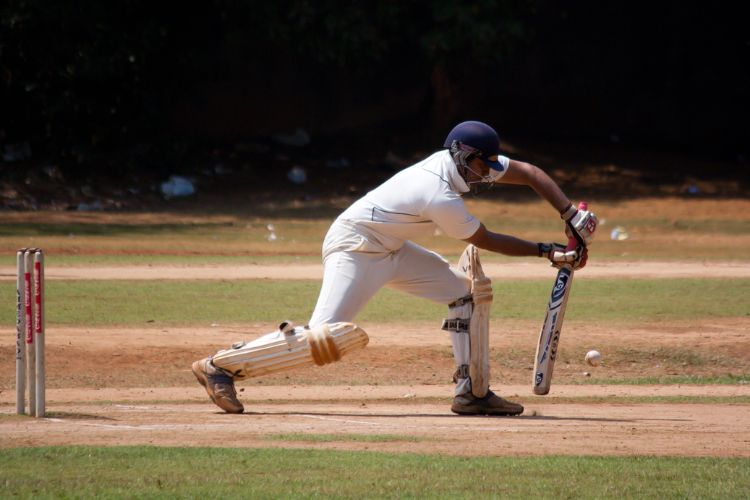We began this series with How to Play the Back Foot Defence, and so it is only natural to continue it with How to Play the Front Foot Defence.
The front foot defensive shot stands as a cornerstone of batting technique in cricket. It is the building foundation from where all other shots begin. Without a good defence, there can not be a good attack.
At its core, the front foot defensive shot entails using the front foot to stride forward towards the ball, meeting it with a solid and well-aligned bat. This is an essential shot for all batters across all formats of the games. It serves as one of the primary methods to thwart the opposition’s bowling attack, and allows you to protect your wicket against good bowling.
How front foot defence contributes to a batsman’s repertoire
The front foot defence is not just a defensive tactic; it is a versatile skill that a batter can build on. If you can master this skill, you can build a strong foundation for your innings. It allows you to master those challenging bowling spells where it seems the bowler has the advantage, and gets you to the place where you can capitalize on bowler tiredness, or a new bowler more to your liking.

Whether you are facing fast bowlers on speedy pitches, or spinners on a turning deck, the ability to execute a front foot defensive shot helps install confidence in your batting abilities as a whole.
The role of front foot defence in negating bowler’s tactics
In every innings there is a battle. It is the battle between bat and ball; between batter and bowler. The bowler strives to get the batter out and the batter strives to survive and then thrive.
The front foot defence is a potent weapon against the bowler’s arsenal of attacks. It nullifies the threat posed by various different bowling strategies, like pace, swing, seam and spin. When you step forward to meet the ball with a strong and solid forward defence, you are reducing the risk of dismissal while maintaining control over our innings.
Additionally, front foot defence allows batters to counteract aggressive bowling tactics, which force bowlers to reassess and change their plans.
Perfecting the Technique: A Batsman’s Guide to Front Foot Defence
At the core of front foot defence lies the forward stride. This is a fundamental movement that positions you as the batter to effectively negotiate incoming deliveries.
The forward stride should be decisive yet controlled. It should allow you to transfer your weight on to your front foot, while always maintaining balance and stability. Proper alignment is crucial; your front foot should point in the direction of the shot you are planning to take, and your body should cover the line of the ball.
Once you have taken that forward stride, you need to focus on positioning your body and bat for optimal defence. Keep your body balanced and upright, your head directly over the front knee to ensure stability and clear sight of the ball.
The bat should be held firmly and flexibly, with the blade aligned towards the ground to meet the ball as low as possible, minimizing the risk of edges.
Not everyone plays the forward defence the same way, and like everything in the game of cricket, you need to adapt the forward defence so that it suits your playing style.
Some batters use the forward defence to blunt the opposition bowlers. They become a wall the ball can not pass, tiring out and frustrating the bowlers until the bowlers make a mistake the batter can capitalize on.
Others use the forward defence as a run scoring opportunity. With just a tiny adjustment, you can use the forward defence to knock the ball into the infield, placing it between fielders to allow a quick single.
And with another adjustment, the forward defence can be an attacking shot. With just a little more power and a slightly longer follow through, the same basic anatomy of a forward defensive shot can become a punch through the covers or down the ground, where you use the bowler’s pace against him. A shot with minimal effort can get you four ways and frustrate the bowler no end.
Influence of Footwork on Defence
While we don’t pretend batting is as graceful as the ballet, batting footwork is akin to a dance. It is a delicate balance between movement and precision that allows the batter to get into precisely the right position to effectively negotiate the opposition bowling. As a batter, you must judge the line and length of the delivery very early, within fractions of a second following the bowler’s release, and begin your foot movement.
As you advance towards the ball with your front foot, the weight transfer from your back foot to your front foot must be executed smoothly and efficiently. Proper alignment with your head positioned over the front knee, helps maintain balance and ensure you are in the best position to play the ball with control and confidence.
To excel in front foot defence, you will need to hone your agility and footwork through targeted exercises and drills. Agility drills like ladder drills, cone drills, and agility ladder hops can help improve foot speed, coordination and balance, allowing you to move swiftly and decisively towards the ball.
Additionally, specific footwork exercises tailored to cricket, such as shadow batting and reactive drills, can help reinforce muscle memory and enhance your ability to judge and react to deliveries effectively.
Reading the ball against pacers, swingers, and spinners
Front foot defence requires you to read the ball effectively, to anticipate its trajectory and to adjust your technique accordingly. All within fractions of a second. When facing fast bowling, you must focus on picking up the line and length early; use your forward stride to meet the ball, head over the knee, the bat close to your pads and angled down.
This sounds difficult; all these actions in just a short amount of time. But as a batter, you must be able to use what might look a disadvantage – very little time – and make it work for you. A fast bowler’s speed is his main weapon, but it also means that the ball comes off the bat faster, and requires less effort from you, as the batter, to produce power. A slight extension of a forward defensive shot can turn a defensive shot into an attacking shot where the ball rockets to the fence with little additional effort from you.
Against swing and seam bowlers, the ability to detect late movement in the air or off the pitch is crucial. You will need to adjust your footwork accordingly and alter your bat angle to counter the swing or seam. You will need to focus on playing with soft hands, and your footwork needs to be precise to negate the movement and minimize the risk of edges.
When facing spin, you need to gauge the degree of turn and bounce, and use your feet to either get to the pitch of the ball, or adjust to a back foot defensive shot. This ability to adjust from forward to back, or back to forward, allows you to disrupt the line and length of the bowler’s delivery, pouting doubt into their mind and increasing the likelihood of poor balls that you can capitalize on.

Training the mind to react instantaneously to diverse deliveries
In additional to honing your technical skills, as a batter you should also train your mind to react instantly to all the different deliveries a bowler may send your way, such that it becomes muscle memory to you.
This will involve developing a keen awareness of your opposition’s bowling tactics, anticipating variations in pace, movement off the pitch or through the air, and spin and variations of bounce. And then, from there, making split-second decisions on how to respond with front foot defence.
And that applies to not just front foot defence, but all batting. A lot of batting is instinctual and muscle memory, but it takes practice and determination to ingrain those instincts and to train those muscles.
Mental exercises such as visualization, scenario-based training, and mindfulness techniques can help you sharpen your focus, to maintain your composure under intense pressure, and to make informed decisions in split seconds in the heat of battle.
Solo drills such as shadow batting allow you to focus on footwork, timing and bat alignment. While partnered drills, such as throwdowns or net sessions, provide you opportunities to simulate match scenarios, allowing you to practice your front foot defence against varied deliveries and bowling styles.
Identifying and Overcoming Common Front Foot Defence Errors
Even the most seasoned of batters are susceptible to common errors in their front foot defence. Common mistakes include lunging too far forward; this leads to imbalance and vulnerability to edges.
Then there’s failing to get your head over your front knee; this leads to poor alignment and compromised stability. And a third error is gripping the bat too tightly; this impedes fluid movement and reduces bat speed.
Feedback from coaches, teammates and your own self-assessment is invaluable in tinkering with and refining your front foot defensive skills. You should never be too proud to seek feedback on your techniques and solicit advice of those areas that you can improve on. Video analysis helps with that, providing valuable insights and allowing you to identify those subtle nuances in your technique that maybe creep in over time that you might have to rectify.
Last Words on Front Foot Defence
It might seem a lot of words to explain what looks like a very simple shot. But the forward defence is the foundation of your batting innings. With a good defence, you will never be in long enough to test out your offensive skills. In later blog posts, we will look at other shots that is in your repertoire as a batter. So we hope to see you then.
If you have any stories to tell of when your forward defence got you through a testing period of bowling, please comment below. We’d love to hear from you. And come back soon to read the next in this series, How to Drive in Cricket.

